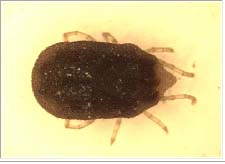Relapsing fever causes
|
Relapsing fever Microchapters |
|
Diagnosis |
|---|
|
Treatment |
|
Case Studies |
|
Relapsing fever causes On the Web |
|
American Roentgen Ray Society Images of Relapsing fever causes |
|
Risk calculators and risk factors for Relapsing fever causes |
Editor-In-Chief: C. Michael Gibson, M.S., M.D. [1] Roghayeh Marandi
Overview
Relapsing fever is a bacterial infection caused by several species of spirochete bacteria in the Borrelia family. TBRF is caused by more the 15 Borrelia species: Borrelia hermsii, Borrelia turicatae, Borrelia parkeri, Borrelia duttonii, Borrelia johnsonii, Borrelia miyamotoi. LBRF is caused by borrelia recurrentis which has a genome so similar to B. duttonii and B. crocidurae (causes of East and West African tick-borne relapsing fever). Humans are the sole reservoirs of Borrelia recurrentis, while small mammals (eg, pets, ground and tree squirrels, chipmunks) and reptiles (lizards, snakes, gopher tortoises) may serve as a reservoir for tickborne Borrelia species.
Causes
Common causes
- Borrelia recurrentis causes louse-borne (epidemic) relapsing fever.
- More than 15 additional Borrelia species can cause tick-borne (endemic) relapsing fever.Tick-borne relapsing fever (TBRF) is transmitted by the Ornithodoros tick (soft body ticks) from a small mammal reservoir and occurs in Africa, Spain, Saudi Arabia, Asia, and certain areas in the western United States and Canada
Borrelia miyamotoi disease can cause tick-borne relapsing fever but is transmitted by hard ticks. (sometimes called hard tick relapsing fever)]
- Borrelia are gram-negative, helical, 8-30 11m long, 0.2-0.5 11m wide, and have 3-10 loosely coiled spirals. They are visible with light microscopy.they are flagellated and highly motile, and they divide by binary fission, with doubling times. They have a unique process of DNA rearrangement in their linear DNA. Each time the DNA is read a different antigenic marker, also known as a variable major protein, is created, which allows the organism to evade the immune system and therefore cause recurrent patterns of fever and other symptoms.
- They are difficult to cultivate on artificial media. Because of frequent antigenic variation, difficult to serotype, and also identifying of Borrelia species by standard bacteriologic methods is problematic, so the nomenclature has relied on the vector specificity of these organisms.
- Humans are the sole reservoirs of Borrelia recurrentis, while small mammals (eg, pets, ground and tree squirrels, chipmunks) and reptiles (lizards, snakes, gopher tortoises) may serve as a reservoir for tick-borne Borrelia species.
Louse-borne relapsing fever
Borrelia recurrentis is the only agent of louse-borne disease. Pediculus humanus, is the specific vector.
- Borrelia organisms that then multiply in the gut of the louse. When an infected louse feeds on an uninfected human, the organism gains access when the victim crushes the louse or scratches the area where the louse is feeding. B.recurrentis infects the person via mucous membranes and then invades the bloodstream.
- No animal reservoir exists
- A single louse can only infect one person, but nosocomial infections are possible from contamination by infected blood.
Tick-borne Relapsing Fever
- More than 15 additional Borrelia species can cause tick-borne (endemic) relapsing fever, which is transmitted to humans through the bite of infected "soft ticks" of the genus Ornithodoros. Soft ticks (family Argasidae) differ in many ways from the so-called hard. Also, Borrelia species are usually associated with specific species of ticks. For example, B. hermsii is transmitted by O. hermsi ticks, B. parkerii by O. parkeri ticks, and B. turicatae by O. turicata ticks. Each tick species has a preferred habitat and preferred set of hosts. They live in the nests of squirrels, chipmunks, and other small animals like chicken & pigs. They feed very quickly(less than a half-hour) and painlessly.
- When rodents or other natural hosts vacate a cabin, humans may become the only available host. Patients usually are unaware of a tick bite or exposure.
The bacteria species associated with TBRF are:
- Borrelia duttoni
- Borrelia hermsii
- Borrelia parkerii.
- Relapsing infections are acquired from "Borrelia hermsii" or "Borrelia parkeri" can be spread from rodents, and serve as a reservoir for the infection, via a tick vector. "Borrelia hermsii" and "Borrelia recurrentis" cause very similar diseases, although the condition associated with "Borrelia hermsii" has more relapses and is responsible for more fatalities. In contrast, the disease caused by "B. recurrentis" has longer febrile and afebrile intervals and a more extended incubation period.

